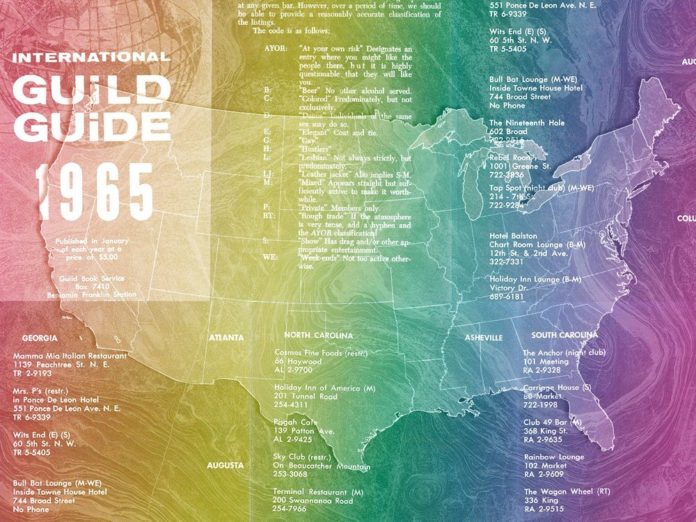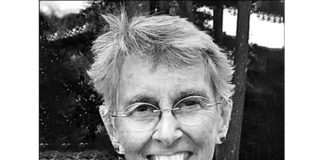:focal(700x527:701x528)/https://tf-cmsv2-smithsonianmag-media.s3.amazonaws.com/filer_public/4c/80/4c80a446-153e-451a-a372-d268220fcb45/map.jpg)
This article is republished from The Food Section. Read the original article.
As big restaurant groups jostle for queer dollars, Pride Month has emerged as a major occasion for LGBTQ limited time offers (LTOs), which is the acronymic way of saying that Dunkin’ has offered rainbow-sprinkled doughnuts and Shake Shack has served Pride Shakes in June.
Such promotions would have been unthinkable as recently as the 1960s, when bars and restaurants were so unhospitable to people who presented as anything but straight that choosing the “wrong” place could end in a beating or arrest.
/https://tf-cmsv2-smithsonianmag-media.s3.amazonaws.com/filer_public/25/eb/25ebcc17-acce-4100-a490-c42e0aff3756/screen_shot_2022-06-06_at_15931_pm.png)
Among the few safeguards available were crowdsourced guidebooks highlighting venues that welcomed gay guests: The Address Book and The Lavender Baedeker are two of the pre-Stonewall titles now commonly described as “gay Green Books,” in reference to The Negro Motorist Guidebook, which helped Black travelers avoid physical harm and discrimination.
But unlike those California-based publications, the International Guild Guide originated in the South.
Guild Press was owned by H. Lynn Womack, the son of Hazelhurst, Mississippi, tenant farmers. As one of his friends complained to the Washington Post in 1978, while the mainstream press insisted on depicting Womack as a “fat, gay, albino” pornographer, he was a “charming, dynamic, thought-provoking man.”
Womack started school at the University of Mississippi but struggled to pay his tuition. He ended up transferring to George Washington University in Washington, D.C., where in the 1950s he purchased a pair of printing houses.
In addition to printing menus and programs for the United Daughters of the Confederacy, Guild Press published a line of physique magazines, leading to Womack’s arrest on obscenity charges in 1960. (He appealed the case to the United States Supreme Court, winning a ruling that erotica marketed to gay men wasn’t automatically obscene.)
Sensing his audience’s enthusiasm for travel, Womack issued his first annual International Guild Guide in 1964.
True to its name, the book included reader-supplied recommendations for clubs and baths in countries such as South Africa, Yugoslavia and Panama. Two-thirds of the 1965 edition, though, were devoted to the U.S., with entries coded to indicate if visitors should anticipate dancing (“D”), a drag show (“S”) or dress code (“E,” for elegant.) “AYOR” stood for “at your own risk,” meaning “you might like the people there, but it is highly questionable they will like you.”
The directory cost $5. But it stands to reason that the guide was also passed between friends.
That’s how it reached the Food Section. A staffer at the Museum of the Shenandoah Valley—a Winchester, Virginia, history museum housed in a stately estate once shared by same-sex couple Julian Glass and Lee Taylor—sent along a digital copy of the 1965 International Guild Guide, suggesting it could be mined for culinary history.
“Unfortunately, we don’t know to what extent [Glass and Taylor] might have used this copy of the Guild Guide to plan their trips,” writes curator Nick Powers in a blog post.
/https://tf-cmsv2-smithsonianmag-media.s3.amazonaws.com/filer_public/f3/22/f32264ea-62da-40b5-9312-2bb235769af9/glass2.jpg)
But in an era when homosexual behavior was criminalized and policed so intensely that Glass wrote “1, 2, 3” instead of “I love you” in letters sent though the U.S. mail, it’s certain that white men traveling in the segregated South consulted the text before deciding where to eat in Roanoke or drink in New Orleans. It would have led them to places “where you could meet other people who were like you,” says Jay Watkins, author of Queering the Redneck Riviera. “They were certainly not marked by rainbow flags.”
(Black men could scan the Guild Guide for venues marked with a “C,” defined as “Colored predominantly, but not exclusively,” while women could look for “L,” meaning “Lesbian, not always strictly, but predominantly,” but the book was otherwise compiled with white men in mind.)
There are dozens of such places listed in the guide’s 1965 edition. Yet only a few of them are labeled “R,” for restaurant. And most of those left no trace on the physical landscape, despite the impression they made on men isolated by a ruthlessly homophobic society.
Still, Watkins urges his students to reflect on the unseen.
“We, whoever the ‘we’ is, have always been everywhere,” Watkins says. “Whether it’s queer history, or Black history or women’s history, it happened in all of the spaces around us: It just looked different.”
He concludes, “The past is a very queer place, indeed.”
A visitor to the Southeast would have found the following restaurants in the 1965 Guild Guide. Each listing is annotated wherever possible with more details than the addresses and phone numbers supplied by the Guide.
Mamma Mia’s Italian Restaurant, 1139 Peachtree St. NE, Atlanta
THEN: Peachtree Street between 10th and 14th streets, just east of Piedmont Park, was a hub of gay social life in the 1960s. According to Wesley Chenault, author of “A Queer New South City: Lesbians and Gay Men in Mid-20th Century Atlanta,” Mamma Mia’s was a popular place to dine before a show at the next-door Piccolo Lounge, known for its resident cabaret singer and no drink minimum.
Mamma Mia promised readers of Gay Atlanta a menu with “12 different pizza pies” and $1.25 Italian dinners, including soup, salad and wine.
NOW: The building that housed Mamma Mia’s is no longer standing, but Epicurean Atlanta is located a few strides away from the downtown corner it occupied.
Mrs. P’s in Ponce de Leon Hotel, 551 Ponce de Leon Ave. NE, Atlanta
THEN: One of the best-known venues among the Guild Guide’s Southern entries, Mrs. P’s was opened in 1956 by Vera and Hubert Phillips. Chenault reports that the Phillips had built up a loyal lesbian clientele when they ran the nearby Piedmont Tavern, where softball players would repair after games, but the hotel basement tearoom became a favorite of gay white men.
After a decades-long run as “Atlanta’s No. One Leather & Western Bar,” Mrs. P’s closed in the early 1980s.
NOW: The former Ponce de Leon reopened in 2021 as Wylie Hotel. The boutique hotel’s signature restaurant is Mrs. P’s Bar & Kitchen, serving “global classics with seasonal Southern flair,” such as grilled peanut hummus and red bean arancini.
/https://tf-cmsv2-smithsonianmag-media.s3.amazonaws.com/filer_public/d4/94/d4940a67-2c03-4ea6-a147-0803c3a85e0f/wylie_hotel-daytime_exterior.jpg)
Downtowner Restaurant, 320 W. Chestnut St., Louisville
THEN: “The other bars and restaurants in that area were straight,” says Louisville artist and activist David Williams, who donated the materials for the University of Louisville’s LGBTQ archive. “You could meet a gal or a guy there, but the Downtowner was different: You could go in and know they were your people.”
Opened in 1953, the Downtowner was one of the few gathering places for gay men that didn’t function primarily as a hotel bar. According to Williams, “The front room was a horseshoe bar: You could sit around and talk.” Although Williams doesn’t recall ordering or hearing about food there, early newspaper ads mention fried chicken and meatloaf. But by the time the venue was destroyed by a fire in 1974, its emphasis was backroom drag shows, among the first in the city.
NOW: One year after the Downtowner burned, its owners opened the tremendously popular “New Downtowner” in a different location. The shell of the original restaurant was razed to make room for a parking lot: A portion of the Hilton Garden Inn Louisville Downtown now sits on the site of the original Downtowner.
Art Shepard’s Embers Restaurant, 200 Tunnel Road, Asheville
THEN: Art and Vivian Shepard opened Embers inside the Host of America Motor Lodge in 1963, then added locations in Hickory and Charlotte. It’s unclear how the restaurant, which went by the nickname “The Times Square of Asheville,” endeared itself to the local gay community, but newspaper ads touted charcoal steaks broiled to order by a chef “who’s not a prima donna. If you want one ‘well done,’ you’ll get it that way without the worry of taking a meat cleaver to your waitress.”
NOW: The hotel that housed Embers was remade in 1985 as Asheville Terrace Apartments, a residential complex for low-income seniors.
Cosmos Fine Foods, 66 Haywood Road, Asheville
THEN: Like Embers, its peer east of downtown, Cosmos is mostly absent from the historical record. It opened in the Nichols Building, across from the present-day Pack Memorial Library, in 1954 (according to its fifth anniversary announcement) or 1956 (according to its tenth anniversary announcement) or 1957 (according to its grand opening invitation.) It seems to have served Greek salads and corned beef.
NOW: Cosmos’ address now belongs to Gentleman’s Gallery, a menswear store.
Hoot Mon Restaurant, 1427 E. Fourth St., Charlotte
THEN: Owned by Nick and Nina Stavrakas, Hoot Mon was the successor to Ringside Grill, where David Hunter worked as a teenager. The Stavrakases “were fresh to the south from Kenosha, Wisconsin, so they weren’t tied up in this segregation stuff,” Hunter, a Black man, told an oral historian. Hoot Mon served coffee and sandwiches late into the night.
NOW: The restaurant has been replaced by a parking lot.
Sky Club, Beaucatcher Mountain, Asheville
THEN: In its 1930s heyday, Gus and Emma Adler’s three-story supper club “was the place to see and be seen, frequented by the business community, politicians, judges and law enforcement,” wrote Asheville raconteur Jerry Sternberg in a 2016 column for the Mountain Xpress. “Even the carriage trade would slip out of the country club to go slumming at this Gatsby-esque speakeasy.”
But the restaurant shed some of its respectability in the late 1960s, when it was taken over by a pyramid schemer who invited Jackie Mason and Regis Philbin to perform at the Sky Club. According to Sternberg, Mason “totally bombed trying to entertain a bunch of us redneck mountaineers—and Regis drank my entire bottle of Scotch.”
Sternberg knew the Sky Club well because he and a pal bought it in the early 1970s. Their patrons by then included “drug dealers, professional shoplifters, bookies, gamblers and probably a couple of hit men … accompanied by assorted pimps and hookers.” But even through a combination of topless waitresses, buffet service and illegal poker, the pair couldn’t turn a profit.
NOW: Developers converted the Sky Club into condos.
Judy’s Place, 410 Jackson, Nashville
THEN: Debbie Bischoff, a research librarian at Nashville Public Library, turned up possibly the only extant reference to Judy’s Place outside of the Guide.
“There was a Spot Burton Restaurant at 410 Jackson in 1963,” she writes. “In 1964, there was a Judy’s Restaurant run by Julia Allen. It was the Speedway Grill in 1966. Apparently, Judy’s did not last long.”
NOW: Judy’s Place’s address was last associated with Strickland Produce, a vegetable sanitation outfit.
Rathskeller, 618 Cherry, Chattanooga
THEN: To most Chattanoogans, the Rathskeller was known as a German restaurant, not a gay gathering place. Albert Schickling, a sometime brewer who immigrated to the U.S. in 1909, opened his first restaurant two years after Prohibition was repealed. “Everyone told me that I would go bankrupt, but I gave Chattanooga what it wanted: a good restaurant,” he told the Chattanooga Times in 1960.
Schickling’s idea of a good restaurant included mounted animal heads and Bavarian paintings on the walls, pickled pig knuckles in the deli case, a blind pianist and an accordion player on stage, and Michelob on tap. When two local businessmen took over the Rathskeller in 1960, they didn’t change much.
The Rathskeller offered its final menu of clam chowder, breaded veal cutlets, turkey sandwiches and apple strudel on Christmas Eve 1970.
NOW: A fire tore through the former Rathskeller in 1972. The building was torn down the following year in conjunction with construction of the Hamilton County Jail.
/https://tf-cmsv2-smithsonianmag-media.s3.amazonaws.com/filer_public/72/a1/72a18cac-59d9-48f2-a425-449277aea948/rath2.jpg)
Show Bar, 233 S. Bellevue, Memphis
THEN: Daneel Buring interviewed 49 men for his doctoral dissertation, “Building Gay Community Behind the Magnolia Curtain,” covering gay Memphis from the 1940s through the 1980s. Several of them agreed that Frank’s Show Bar Lounge, opened in 1962, was the city’s first gay bar. It also became the city’s first integrated gay bar in 1965, when a Black man named Alan Dillard ordered and received a drink.
The “Frank” of the lounge’s name was Frank Radford, who in 1969 left the business to open El Morocco in a former VFW hall. Prior to its opening, the Commercial Appeal reported, “Frank has been operating Frank’s Show Bar, sometimes known by gayer names, at Eastmoreland and Bellevue. ‘I have made it plain to the patrons of that place that I am looking for a new, entirely different clientele at my new place.’”
While Buring’s interviewees didn’t disclose many details about the inside of Radford’s first restaurant, they recalled police officers congregating outside of it, writing down patrons’ license plate numbers.
NOW: An apartment building stands on the Show Bar site.
Hanna Raskin is the editor and publisher of The Food Section, a twice-weekly newsletter about food and drink in the American South. She was formerly the food editor and chief critic for the Post and Courier.
Recommended Videos







